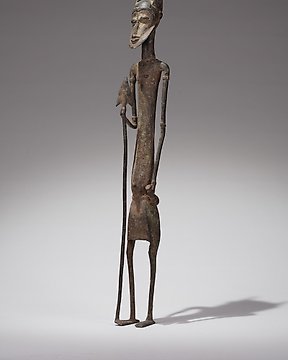
Bamana - Mali (Ingen reservasjonspris)
Nr. 84047329

Nr. 84047329

A male bronze Senufo rider, sitting on the saddle of a well groomed horse, is holding a flute and a staff, the rider sitting up straight has many rounded marks on his stomach and abdomen, perhaps keloid marks, his head is raised, of oval shape, composed of a pointed mouth, small nose and large almond eyes. The horse with its very stylized body parts is characterized by rich ornamentation, the large head is rather untypical for a horse; beautiful age patina.
The Senufo 'associate horses with leadership, wealth, status, hunting and militarism. Riders sculpted by Senufo artists are often armed with spears at the ready. They represent the multi-dimensional powers of madabele (forest or 'bush' spirits). In equestrian statuary a bush spirit is shown as a forceful, well-armed leader, or fanhafolo ('power-owner'). Bush spirits are capricious, fast-traveling, nocturnal, mysterious and aggressive. (...) Such figures are display pieces in a diviner's or priest's shrine where. . . they connote luxury, good taste and prestige' (Cole 1983: 11-13).
"Horses are very rare in Africa. The few to be found west of Sudan, from the lands of the Sahara and Sahel down to the fringes of the tropical forests, belong to the king, the chief warrior and to notable persons. Due to the dense humidity of the tropical rainforest and the deadly tsetse fly, only restricted numbers of horses survive. And yet rider and mount sculptures are common among the Dogon, Djenne, Bamana, Senufo and the Yoruba people. The Akan-Asante people of Ghana and the Kotoko of Chad produced a good deal of small casting brass and bronze sculptures. Some of the artists could barely even have caught a glimpse of a horse." George Chemeche
Lit.: Burkhard Gottschalk: Senufo. Massa und die Statuen des Poro, 2002; Staatliche Museen der Preußischer Kulturbesitz, Museum für Völkerkunde Berlin, Die Kunst der Senufo, Elfenbeinküste. Mit einem Beitrag von Till Förster, 1990; Museum Rietberg Zürich, Die Kunst der Senufo aus Schweizer Sammlungen, 1988; Susan Elizabeth Gagliardi, Senufo unbound. Dynamics of art and identity in West Africa, Cleveland 2015.
Hvordan kjøpe på Catawiki
1. Oppdag noe spesielt
2. Legg inn det høyeste budet
3. Å gjøre en sikker betaling